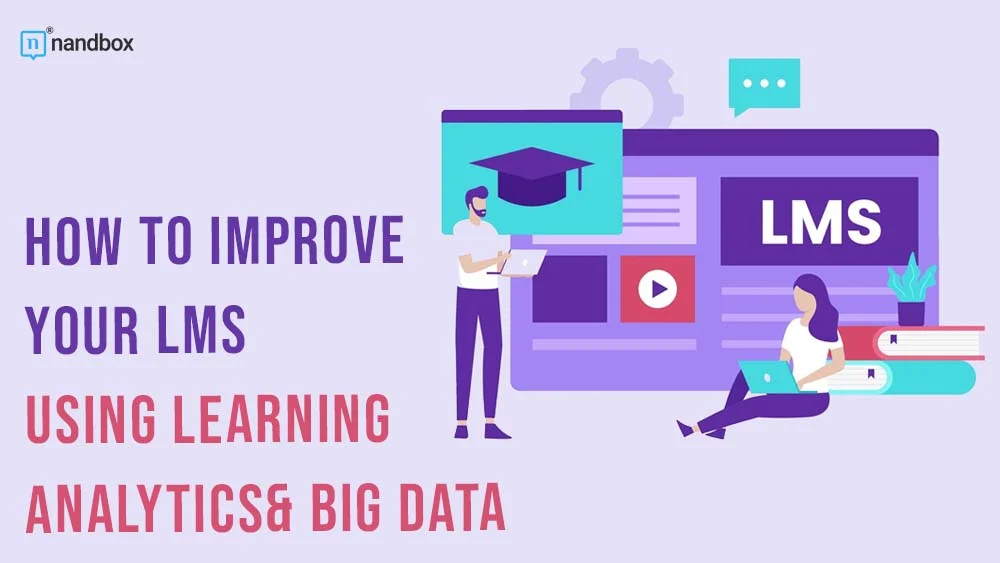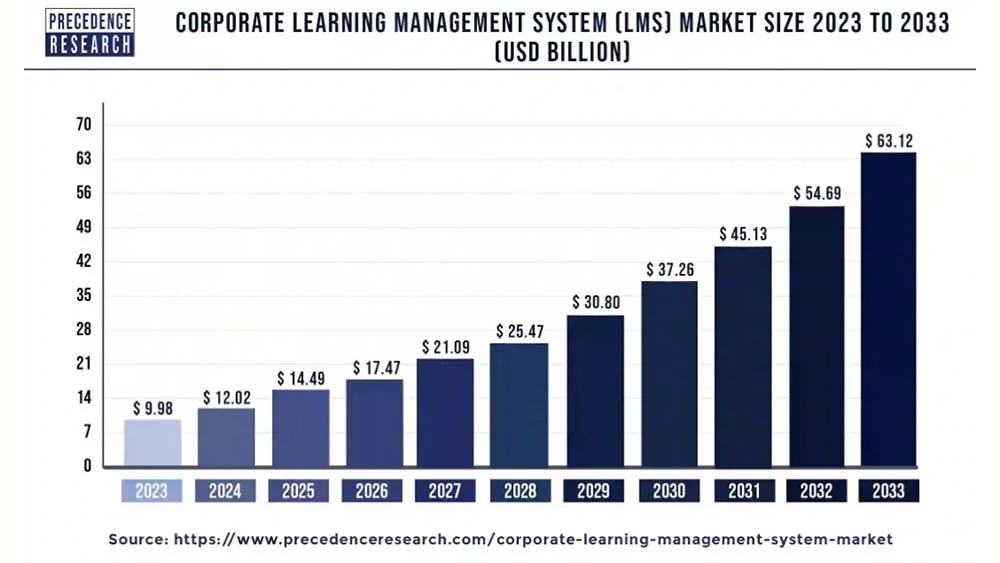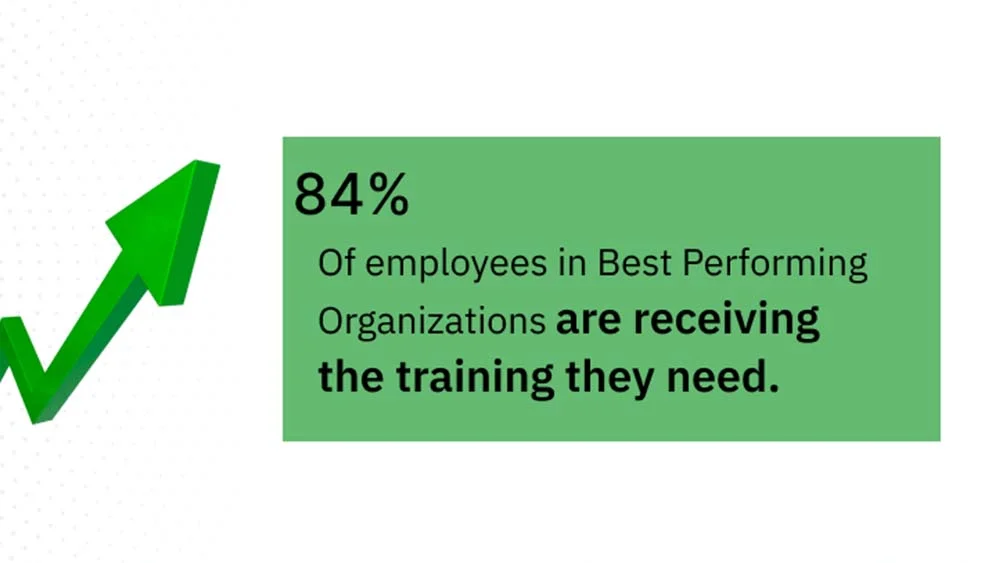How to Improve LMS Using Learning Analytics & Big Data
E-learning is booming in popularity, both in academic and corporate settings, with Learning Management Systems (LMS) serving as a convenient tool for implementing learning programs. The global corporate LMS market is expected to reach about $63.12 billion by 2033, thus showing huge opportunities for corporate e-learning worldwide. But how to improve LMS using learning analytics and big data?
If you’re using an LMS but find its efficiency lacking, there’s a solution: leverage Learning Analytics and Big Data to enhance your system. In this article, we’ll explore how integrating big data analytics for education can elevate corporate learning to new heights.
Let’s dive in.
Source: www.precedenceresearch.com
LMS equipped with Learning Analytics and Big Data: Key insights
The functionality of an LMS revolves around managing two main elements: learners and content. To be more precise, the main idea is to train the employees. Content is developed, modified, expanded, and directed to specific groups of learners within the system, facilitating the traditional delivery of knowledge. However, with the integration of learning big data analytics into LMS platforms, this process has evolved significantly. Now, users can gather feedback from learners, access detailed analytics regarding learner behavior, and effectively utilize that data to enhance the learning experience.
Understanding Learning Analytics
In e-learning, data analytics for a SkillSoft Pricing involves the collection, analysis, and interpretation of data gathered from learners’ interactions with learning materials and assessment. Learning Management System involves the collection, analysis, and interpretation of data gathered from learners’ interactions with learning materials and assessment tools. LMS analytics provides insight into the learning process, allowing us to understand how learning unfolds. This data enables us to tailor learning methods to individual learner needs, optimize course content and design by identifying patterns and trends, and ultimately deliver a personalized learning experience.
Understanding Big Data
When it comes to big data analytics for education, it refers to a wealth of information that provides insights into how learners gain information and grow professionally. It’s like having a vast library of valuable knowledge, where every piece of data, whether it’s test scores or video views, helps us understand patterns and trends in learning.
Through learning big data analytics, organizations can collect and evaluate different types of data, regardless of size or velocity, to make more informed decisions. While there’s still much to learn about how to effectively use big data, it’s clear that traditional data analysis methods are no longer sufficient. Big data is the future of education.
Learning Analytics & Big Data in LMS: What do you get?
Utilizing learning analytics and big data in the LMS equips us with powerful tools to enhance learning:
- LMS analytics provides insights into individual learning behavior.
- Big data offers a broader perspective on learning trends.
When combined, they enable us to:
- Gain a deeper understanding of learners by uncovering details such as demographics, interests, and preferences.
- Monitor how learners interact with the LMS, identifying patterns such as content they skip, areas where they struggle with, and topics they breeze through.
- Segment learners based on interests, topics, and performance to predict knowledge and skill acquisition within each group.
As a result, learning becomes increasingly personalized, with big data and learning analytics shaping learning experiences to fit each individual’s expertise, skills, learning patterns, and interests.
How to Improve LMS Using Learning Analytics & Big Data
Businesses utilize big data analytics for educational purposes primarily to cut down on training costs, facilitate reskilling and upskilling of employees, and accelerate the acquisition of knowledge and skills needed to improve job performance.
With these goals in mind, you may be interested in how to build an AI-based LMS that could be tailored to your organization’s unique challenges and industry requirements. This makes sense, as learning analytics and big data hold immense potential to not only enhance the learning analytics platform itself but, more importantly, to improve learning outcomes that lead to improved business performance.
That’s why it’s time to take a closer look at the specific benefits.
The benefits of investing in corporate training are measurable
When you invest in online training for your employees, you expect to see a return on that investment. An LMS equipped with learning analytics can help you determine whether this is the case.
With an advanced assessment system, including surveys and scores, you can measure the current level of knowledge and skills at the end of each course. This helps you determine whether it’s worth continuing to invest in a particular course, whether additional modules are needed, or whether the course has been completed and no further investment is necessary.
LMS data analytics provides insight to optimize training budgets and ensure that resources aren’t wasted.
You can keep an eye on how learning is going and make adjustments quickly if needed
This is all thanks to real-time reporting, a key feature of a learning platform with big data and learning analytics. It helps you keep track of how employees are learning and allows you to react fast if something isn’t going as planned, such as modules aren’t getting finished or there’s a backlog.
These real-time reports are sorted by various categories, such as courses, learners, or business units. This makes it easy to see what’s happening and keeps the learning process running smoothly. Most importantly, it lets you step in right away to fix any problems or provide extra help to learners.
You can easily see how well your LMS is working
Your LMS not only stores learning content, it also collects data about learners. With big data analytics built into your learning system, you’ll get the latest insights into:
- How engaged learners are
- Each learner’s unique learning patterns
- How quickly they’re completing modules and courses, and more.
With all of this information at your fingertips, you can transform employee training from an option into a powerful, customized tool that delivers the results your business needs.
You can integrate your LMS with other systems for comprehensive business coverage
Corporate training doesn’t have to interfere with learners’ daily tasks or business goals. Instead, when you connect your training system to your CRM or employee management systems, you’ll discover:
- How training affects real-world results, such as whether sales training increases sales, conversion rates, or audience reach.
- The return on investment (ROI) of training.
- How training affects employee turnover and engagement.
Interestingly, studies show that companies are 17% more productive when employees receive the training they need.
In addition to tracking employee performance, LMS analytics and big data can help identify employees who show initiative, leadership, or signs of burnout. Encouraging initiative and addressing potential problems promptly is critical, don’t you think?
As you can see, an LMS isn’t just limited to training programs; it can also help with virtual onboarding, performance reviews, and improving sales, all while saving time and money.
You can attract top candidates and thus boost business performance
Opportunities for professional growth and development are critical to attracting candidates. For example, 92% of candidates prefer companies that offer learning and development opportunities. In addition, companies that invest in employee training are seen as top performers, with 84% of employees feeling they receive adequate training. This highlights how employee development sets industry leaders apart.
Source: IBM. The Value of Training.
With these points in mind, we’ve shown not only how to drive the effectiveness of your LMS with learning analytics and big data, but also how to translate improved employee learning into revenue growth and business development. Do you agree?
Ready to embrace the benefits of an LMS with Learning Analytics and Big Data?
Learning that isn’t applied at work isn’t just unfortunate; it’s a significant issue for executives. When employee training doesn’t translate into business benefits, it’s a missed opportunity.
However, an LMS with learning analytics and big data can change the game. It helps by:
- Keeping tabs on learner progress in real-time.
- Identifying areas where learners are struggling.
- Providing relevant learning content that aligns with business goals.
- Increasing course completion rates and reducing attrition.
- Maximizing return on investment in employee training.
Now that you know how to improve LMS using learning analytics and big data, the next step is to deliver a quality learning experience to your employees, such as interactive training solutions, thereby boosting your business performance and bottom line.







